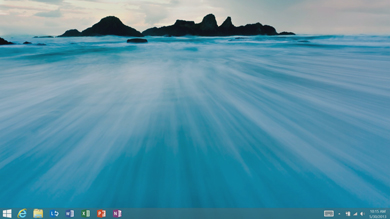News
Microsoft Releases Windows 8.1 Preview, Unveils 'Bing as a Platform'
Related:
Microsoft CEO Steve Ballmer announced the availability of the Windows 8.1 public preview on Wednesday during the opening keynote of the Build conference, taking place this week in San Francisco.
Existing Windows 8 users can access the preview in the Windows Store. It's also available for download here.
The most common complaint about Windows 8 since its release has been its failure to appeal to users who are accustomed to the traditional Windows desktop, a fact that Ballmer tacitly acknowledged during his keynote presentation.
"What we will show you today is a refined blend of our desktop experience and our modern user interface and application experience," Ballmer said. He positioned Windows 8.1 as a re-tweaking that Microsoft hopes will address the key objections users have had to Windows 8.
Since Windows 8's release last October, Ballmer said about 100,000 applications have appeared in the Windows Store that run on the new modern interface and application model. However, he also said there are 2 to 3 million applications designed to run on the traditional Windows desktop environment. With Windows 8.1, Microsoft is aiming to make it easier for users to access the environment and applications they prefer, while making clear that over time it hopes to see most key applications move to the new model.
As promised, Windows 8.1 restores the Start button back to Windows, along with a bootable desktop.
 [Click on image for larger view.]
The Windows 8.1 preview Desktop start screen.
[Click on image for larger view.]
The Windows 8.1 preview Desktop start screen.
"You will see that we [brought] back the Start button to the desktop," Ballmer said. "If you want to boot to the desktop, you can boot to the desktop." The audience of 6,000 responded with a rousing applause.
Windows 8.1 on Display
Julie Larson-Green, corporate vice president of Windows, took the stage to demonstrate the new capabilities coming in Windows 8.1, noting that Microsoft had made 800 updates to Windows 8 since its launch.
She showed off new gesture support that makes it easier to select auto-fill text options when typing with the on-screen keyboard. She also demoed the new hands-free mode that lets users interact with a tablet or device without touching the screen.
Windows 8.1 will provide significantly improved multitasking support, thanks to a more flexible multi-window interface than the one-third/two-thirds model required in Windows 8. Larson-Green showed off a dual-monitor system displaying eight Windows Store UI apps -- four on each screen. She also showed how Windows 8.1 automatically resizes and snaps a new window onto the display when users open new messages in Outlook.
Other UI enhancements include the ability to quickly access the All Apps screen with a simple upward swipe, and to better manage that screen by viewing apps by name, date installed, category and recent use. Larson-Green also showed how users can customize the look and feel of the Windows 8 background, including support for background animation that responds to scroll events.
One feature that drew applause was updated access to key apps directly from the lock screen, eliminating the need for a log-on. Larson-Green showed how users in Windows 8.1 can answer an incoming video chat call without logging into the tablet, by touching the notification icons in the lock screen. She also said that users will be able to access the Camera from the lock screen, as well.
Bing Surprise
Perhaps the biggest surprise of the day was the news that Microsoft is positioning Bing as a development platform.
Ballmer said that Microsoft is embedding its Bing search engine properties across its line of products. It will include adding the Bing search engine to Windows 8.1, as well as to Windows Phone, Office, Skype and Xbox. Microsoft calls the project "Bing as a Platform."
"With Windows 8.1, I would say Bing is inside," Ballmer said. "Our shell experience is powered by Bing. You'll see we are opening up Bing as an application development platform, so you can use all this investment we have put into crawling the Web and understanding entities. You can use that, see that and build that richness into your applications running on top of Windows."
In addition to bringing Bing to Windows, Corporate Vice President Gurdeep Singh Pall announced that Microsoft was making available new APIs that allow developers to integrate rich Bing functionality into their Windows Store apps.
Pall showed off a travel companion app that leverages Bing to provide a suite of rich features built around travel. Voice input, contextual search, optical character recognition, language translation and 3-D map display were all highlighted in the sample app.
"The unbounded knowledge of the Web is now available to you in your applications," Pall told the audience.
About the Authors
Michael Desmond is an editor and writer for 1105 Media's Enterprise Computing Group.
Jeffrey Schwartz is editor of Redmond magazine and also covers cloud computing for Virtualization Review's Cloud Report. In addition, he writes the Channeling the Cloud column for Redmond Channel Partner. Follow him on Twitter @JeffreySchwartz.